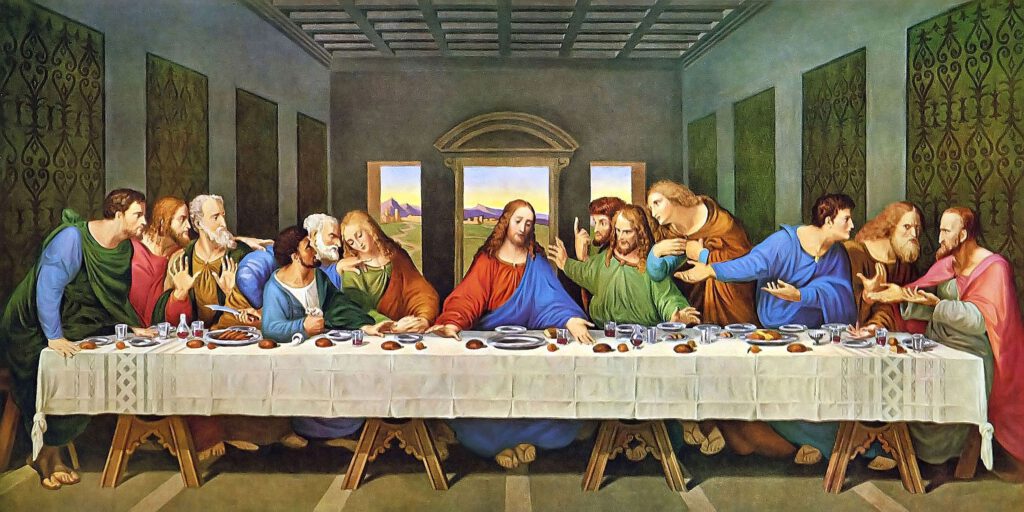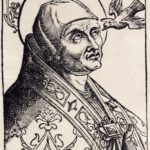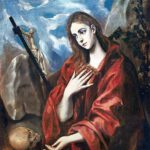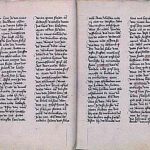Maria Magdalena verschijnt op verschillende plaatsen. Ik bespreek er hier enkele. evenals de moderne interpretaties van haar historische rol.
Volgens de gnostische evangeliën
Vanaf 1896 werden fragmentarische manuscripten, bekend als de gnostische evangeliën, ontdekt door theologen en archeologen. Het evangelie van Maria, waarvan wordt aangenomen dat het in de 3e eeuw is geschreven, onthult een Maria Magdalena die een speciale relatie met Jezus had en een dieper begrip van zijn leringen bezat. Het evangelie van Filippus beschrijft de relatie van Maria met Jezus als partner of metgezel. Dit is geïnterpreteerd als was hun relatie een intieme.
Moderne interpretaties
Maria Magdalena blijft een object van fascinatie voor zowel religieuze geïnteresseerden als mensen in seculiere media, bijvoorbeeld:
- In Martin Scorsese’s verfilming van Nikos Kazantzakis‘ roman The Last Temptation of Christ,
- in Andrew Lloyd Webbers musical Jesus Christ Superstar en
- in Mel Gibson’s The Passion of Christ,
wordt Maria afgebeeld als de berouwvolle zondaar.
Echter, Dan Brown’s populaire roman The Da Vinci Code portretteert Maria als de discipel aan de rechterkant van Jezus in Da Vinci’s schilderij Het Laatste Avondmaal en de zwangere vrouw van Jezus toen hij werd gekruisigd.

Onderzoek
Hoewel we 2000 jaar later wel iets weten over de Joodse samenleving in het oude Palestina, weten we heel weinig over Maria zelf. De Bijbel geeft geen persoonlijke details over haar leeftijd, status of familie.
Magdala
Haar naam, Maria Magdalena, geeft ons de eerste echte aanwijzing over haar. Het suggereert dat ze uit een stad genaamd Magdala kwam. Er is een plaats die tegenwoordig Magdala heet, 200 kilometer ten noorden van Jeruzalem aan de oevers van het Meer van Galilea.
We weten uit de literatuur dat er ook een oude plaats was genaamd Magdala. De naam komt voor in het Nieuwe Testament, maar ook in joodse teksten. De volledige naam is Magdala Tarichaea.
Magdala lijkt toren te betekenen en Tarichaea betekent gezouten vis. Als de naam van de stad Toren van de Zoute Vis was, is het geen verrassing dat de visserij daar de hoofdactiviteit was.
Als vrouw die in Magdala woont, heeft Maria mogelijk op de vismarkten gewerkt en de vissers ontmoet.
Een joodse tekst waarin Magdala wordt genoemd, zegt dat Magdala door God wordt veroordeeld en vernietigd vanwege haar hoererij. Het is mogelijk dat deze beschrijving van Magdala als plaats van hoererij de oorsprong is van het idee dat in het westerse christendom ontstond dat Maria Magdalena een prostituee was.
We weten dat er elders rond de Middellandse Zee bordelen waren, en Galilea was waarschijnlijk geen uitzondering. Het maakte deel uit van het Romeinse rijk, dat een zware belastingdruk op gezinnen legde, en vaak betaalden vrouwen de zwaarste prijs.
Ongetrouwde vrouw
Toen de belastingdruk het ergst was en een gezin zijn schulden niet meer kon afbetalen, werden kinderen soms als slaven afgestaan. Misschien was dit het lot van Maria Magdalena. Met zo’n harde achtergrond is het niet moeilijk voor te stellen dat Maria een prostituee was, maar dit bewijs is puur indirect.
Haar naam, Maria van Magdala, zou echter iets anders kunnen suggereren: ze was ongehuwd. Een getrouwde vrouw zou de naam van haar man hebben gedragen en Maria niet.
Er is niets in de beperkte hoeveelheid materiaal in de evangelietradities over Maria dat suggereert dat ze getrouwd is. Ze wordt nooit beschreven als weduwe en er wordt ook niet gezegd dat ze kinderen heeft. 2000 jaar geleden werd een ongehuwde vrouw met argwaan bekeken.
Misschien raakte Maria hierdoor geïsoleerd, maar het kan haar negatieve imago niet volledig verklaren.
Buitenstaander
Kan iets anders in Maria’s leven haar tot een verschoppeling hebben gemaakt?
Het evangelie van Lucas vertelt ons dat Jezus zeven demonen uit Maria verdreef (Lukas 8:2).
Jezus stond in die tijd bekend als een exorcist. In alle evangeliën is exorcisme een van de belangrijkste dingen die hij doet in zijn campagne voor een vernieuwing van Israël.
De uitdrijvingen en genezingen gaan waarschijnlijk samen met het leren en prediken dat het koninkrijk van God nabij is. In die tijd geloofden mensen dat de demonen mensen bezaten die iets verkeerds hadden gedaan en het verdienden bezeten te zijn, terwijl goede, deugdzame mensen werden beschermd tegen bezetenheid door demonen. Wat de oorzaak van haar bezetenheid ook mag zijn, Maria’s exorcisme is de katalysator die ervoor zorgt dat ze zich aanmeldt bij de Jezus-beweging.
De boodschap die Jezus zou hebben gepredikt, lijkt vooral aan te spreken op mensen die zich in de marge van de samenleving bevinden. Lukas (in hoofdstuk 8) vertelt ons dat Maria een van Jezus’ volgelingen was en met hem mee reisde.



